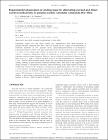| dc.contributor.author | HUTZLER, STEFAN | en |
| dc.contributor.author | BLAU, WERNER | en |
| dc.contributor.author | COLEMAN, JONATHAN | en |
| dc.contributor.author | DRURY, ANNA | en |
| dc.date.accessioned | 2010-07-13T10:20:09Z | |
| dc.date.available | 2010-07-13T10:20:09Z | |
| dc.date.issued | 2002 | en |
| dc.date.submitted | 2002 | en |
| dc.identifier.citation | Kilbride B E, Coleman J N, Fraysse J, Fournet P, Cadek M, Drury A, Hutzler S, Roth S and Blau WJ, Experimental observation of scaling laws for alternating current and direct current conductivity in polymer-carbon nanotube composite thin films, Journal of Applied Physics, 92, 7, 2002, 4024 - 4030 | en |
| dc.identifier.other | Y | en |
| dc.identifier.uri | http://hdl.handle.net/2262/40261 | |
| dc.description | PUBLISHED | en |
| dc.description | [also in "Virtual Journal of Nanoscale Science & Technology", September 30, 2002, Volume 6, Issue 14 | en |
| dc.description.abstract | Alternating current (ac) and direct current (dc) conductivities have been measured in polymer-nanotube composite thin films. This was carried out for a range of concentrations of multiwall nanotubes in two polymer hosts, poly(m-phenylenevinylene-co-2,5-dioctyloxyp-phenylenevinylene) (PmPV) and polyvinylalcohol (PVA). In all cases the dc conductivity ?DC was ohmic in the voltage range studied. In general the ac conductivity displayed two distinct regions, a frequency independent region of magnitude ?0 at low frequency and a frequency dependent region at higher frequency. Both ?DC and ?0 followed a percolation scaling law of the form ??(p?pc)t with pc=0.055% by mass and t=1.36. This extrapolates to a conductivity of 1?10?3?S/m for 100% nanotube content. Such a low value reflects the presence of a thick polymer coating, resulting in poor electrical connection between tubes. This leads to the suggestion that charge transport is controlled by fluctuation induced tunneling. In the high frequency regime the conductivity increases with frequency according to an approximate power law with exponent s?0.92, indicative of hopping transport. The onset of this frequency independent conductivity scales with mass fraction for the PmPV composite due to the variation of correlation length with nanotube content. This behavior is discussed in terms of a biased random walk in three dimensions. In addition ac universality is demonstrated by the construction of a mastercurve. | en |
| dc.description.sponsorship | The authors wish to acknowledge the Irish Higher Educational
Authority as well as EU TMR Project
COMELCAN for financial support. | en |
| dc.format.extent | 4024 | en |
| dc.format.extent | 4030 | en |
| dc.language.iso | en | en |
| dc.relation.ispartofseries | Journal of Applied Physics | en |
| dc.relation.ispartofseries | 92 | en |
| dc.relation.ispartofseries | 7 | en |
| dc.rights | Y | en |
| dc.subject | Physics | en |
| dc.subject | multiwall nanotubes | en |
| dc.title | Experimental observation of scaling laws for alternating current and direct current conductivity in polymer-carbon nanotube composite thin films | en |
| dc.type | Journal Article | en |
| dc.contributor.sponsor | Higher Education Authority (HEA) | en |
| dc.type.supercollection | scholarly_publications | en |
| dc.type.supercollection | refereed_publications | en |
| dc.identifier.peoplefinderurl | http://people.tcd.ie/shutzler | en |
| dc.identifier.peoplefinderurl | http://people.tcd.ie/colemaj | en |
| dc.identifier.peoplefinderurl | http://people.tcd.ie/wblau | en |
| dc.identifier.peoplefinderurl | http://people.tcd.ie/adrury | en |
| dc.identifier.rssinternalid | 24630 | en |
| dc.identifier.rssuri | http://dx.doi.org/10.1063/1.1506397 | en |




